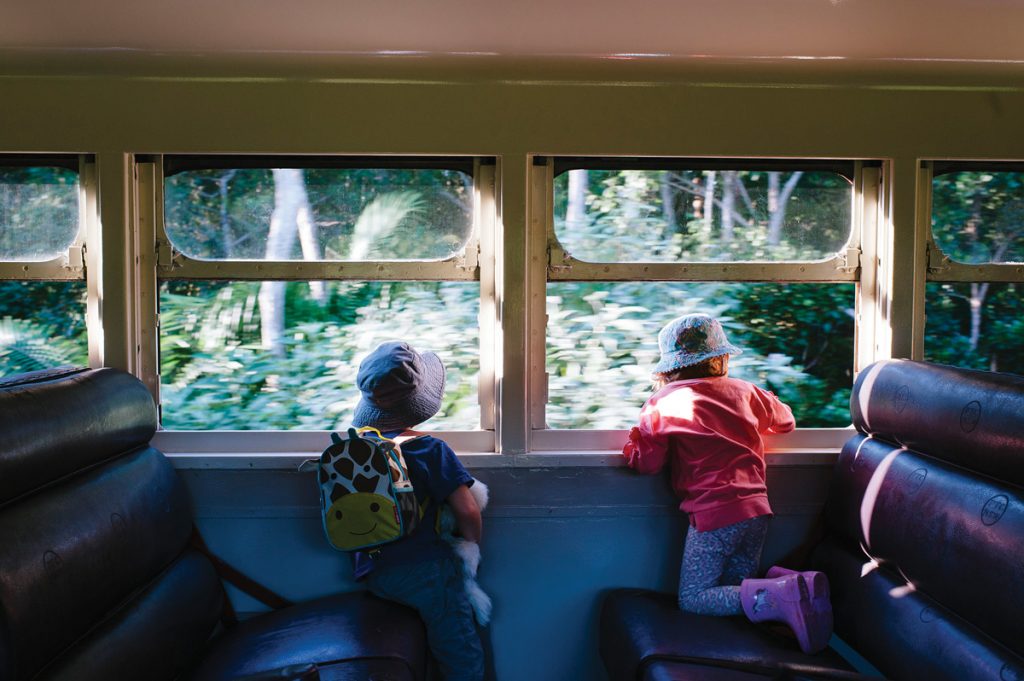Shine On
Byron Bay has long shed its dreadlocked hippie image, but sustainability remains a priority in a lively green precinct on the outskirts of town.
Listening to the sound of the ocean as we walk through a littoral rainforest, it’s hard to believe that the upscale boutiques and bars in Byron Bay’s township are just a few minutes’ drive away. The walking track can be found on the grounds of sustainable luxury resort, Elements of Byron, and weaves through two kilometres of native bushland which boasts four different ecologies.
With ecotourism one of the fastest growing sectors of the travel industry, the low-rise Elements, set on a prime 20 hectares of land with two kilometres fronting Belongil Beach, has the seal of approval from the tight-knit, green-minded local community and tourists alike.
Resort-style lodgings are not usually our choice of accommodation; however, after a morning on the pristine, mostly deserted beach, a dip in the adults-only pool – where a sign reads “Save Water Drink Tequila” – and exploring the sprawling grounds, we are pleasantly surprised.
The striking natural landscape may be the hero of the property but the neutral-toned eco villas, spread meticulously around the grounds, are luxurious places to relax and reset. Later on, sipping a glass of shiraz and looking out the louvre windows from the villa’s freestanding bathtub as the sun disappears behind the eucalypt forest, a curious wallaby is the only sign of life.
“We are equally as happy with what we didn’t do as we were with what we did do with the site,” Elements’ Property Development Director, Jeremy Holmes, says of the low-impact development. “It took a lot of restraint.”
The following morning after yoga on the lawn, we indulge in a breakfast at Graze restaurant where dishes are prepared with produce sourced from the region’s stellar food bowl. Dishes such as sweet corn avocado fritters with harissa and macadamia dukkah are offered in addition to a market style buffet.
After breakfast, we set off to visit the new Habitat precinct near Byron’s hidden creative hub, the Arts and Industrial estate, a short bike ride away. The brainchild of music festival guru Brandon Saul and designed by award-winning Dominic Finlay Jones, Habitat is a vibrant retail, commercial and residential village – the first of its kind in Australia.
At the heart of the development is Argentinian bistro Barrio, a collaboration between hospitality aficionados Tristan and Kassia Grier, of Newrybar’s Harvest; Dan Wyllie of New York establishments Flinders Lane, Saxon and Parole; and Argentinean chef, Francisco Smoje. An eclectic crowd of hipsters and creatives sits at shared tables in the alfresco eating areas, while families and surfers swing by to pick up coffee and treats from the cabinets on the way to the beach.
Inside, the open Argentinian woodfired oven and charcoal grill is getting a workout as a casually-dressed crowd feasts on dishes like roasted half-cauliflower with chickpeas, almonds and sage and grilled beef rib and chimichurri from local producers – conscious eating is the ethos here.
If anywhere showcases Byron Bay’s cultural shift, it is the Habitat village where linen-clad ladies rub shoulders with barefoot, wild-haired kids and young professionals from the coworking spaces on-site.
We wander through Habitat Women, a retail collective boasting local labels like Rowie and Temple of the Sun jewellery. While at Habitat Home, we’re tempted to buy another suitcase and take home a Berber Tigmi Trading rug, and ceramics by local artisans.
Aesthetically pleasing with its central courtyard, subtropical landscaping and outdoor meeting spaces, Habitat also sets a new standard in environmental sustainability. Saul tells me that Habitat has been set up as an off-the-grid solar farm so tenants can sell their electricity to each other. Stormwater is treated on-site, rainwater recycled, electric car charge stations and bike racks are provided and there’s a large wetland for the native Wallum froglets and birdlife.
Across the road, we wait for the world’s first solar-powered train to take us into Byron town for the afternoon. Operated by the not-for-profit Byron Bay Railroad Company, the restored 70-year-old train runs a return service from North Beach Station to Byron’s township each day. After paying my three dollars, I take a seat in the former first class carriage, as affable inspector and long-time Byron local, Sharee Ettridge, clips the cardboard ticket.
When the solar train launched last December, it was the first time the 110-year-old tracks had been used in 13 years and, as a frequent visitor to Byron, it’s a treat for me to admire the lush, three-kilometre stretch of coastline from my sun-drenched leather seat.
On cloudier days, there are 30 kilowatts of solar panels, which can be connected by cables to top up the train’s lithium-ion battery bank.
“Travellers are looking for a sustainable outcome, more than just an experiential travel experience,” Holmes later tells me of Byron Bay’s popularity with the eco-conscious traveller.
It seems there’s more to come with Elements set to open an eco-interpretative community centre. The education facility will be completely off-the-grid and will be available to schoolchildren and locals who will be invited to come and learn about the environment and sustainability practices.
There are also plans for a 500-square-metre vegetable garden, where Elements’ sustainability team will explore new urban food production technologies with Southern Cross University. The facility will also process organic waste from the resort.
Luxury with a conscience, what’s not to love about that?
elementsofbyron.com.au
habitatbyronbay.com
byronbaytrain.com.au











